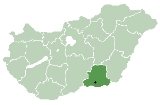
Pusztaszer
Encyclopedia

Village
A village is a clustered human settlement or community, larger than a hamlet with the population ranging from a few hundred to a few thousand , Though often located in rural areas, the term urban village is also applied to certain urban neighbourhoods, such as the West Village in Manhattan, New...
in Csongrád
Csongrád
Csongrád is a town in Csongrád County in southern Hungary. Formerly, the city also had the alternate Slavic name of Černigrad, which, like the Hungarian version, means "Black Castle" or "Black Town".-History:...
county, in the Southern Great Plain
Southern Great Plain
Southern Great Plain is a statistical region of Hungary. It is part of Great Plain and North region. Southern Great Plain includes the 3 counties:* Bács-Kiskun* Békés* Csongrád...
region
Region
Region is most commonly found as a term used in terrestrial and astrophysics sciences also an area, notably among the different sub-disciplines of geography, studied by regional geographers. Regions consist of subregions that contain clusters of like areas that are distinctive by their uniformity...
of southern Hungary
Hungary
Hungary , officially the Republic of Hungary , is a landlocked country in Central Europe. It is situated in the Carpathian Basin and is bordered by Slovakia to the north, Ukraine and Romania to the east, Serbia and Croatia to the south, Slovenia to the southwest and Austria to the west. The...
.
Geography
It covers an areaArea
Area is a quantity that expresses the extent of a two-dimensional surface or shape in the plane. Area can be understood as the amount of material with a given thickness that would be necessary to fashion a model of the shape, or the amount of paint necessary to cover the surface with a single coat...
of 48.93 km² (19 sq mi) and has a population
Population
A population is all the organisms that both belong to the same group or species and live in the same geographical area. The area that is used to define a sexual population is such that inter-breeding is possible between any pair within the area and more probable than cross-breeding with individuals...
of 1674 people (2002).
Sightseeing
A National Memorial Park has been erected in the neighborhood of the village to remember the first parliamentary meeting of Hungarians in 895-896. In a great hall the circular panorama painting of Árpád FesztyÁrpád Feszty
Árpád Feszty was a Hungarian painter.He was born in the town of Ógyalla . His ancestors were German settlers . He was the fifth child of Silvester Rehrenbeck , an affluent landowner at Ógyalla, and his wife Jozefa...
was rebuilt and related exhibitions form an important national museum of Hungary.
In the Memorial Park a village museum has been also rebuilt (Skanzen). There old buildings once popular in the Great Hungarian Plain
Great Hungarian Plain
The Great Hungarian Plain is a plain occupying the southern and eastern part of Hungary, some parts of the Eastern Slovak Lowland, southwestern Ukraine, the Transcarpathian Lowland , western Romania , northern Serbia , and eastern Croatia...
can be visited together with old workshops. For example the old car factory consisted of the three workshops of the wheel-maker, the ladder-mount maker and the blacksmith masters.
The ruins of an old Benedictine
Benedictine
Benedictine refers to the spirituality and consecrated life in accordance with the Rule of St Benedict, written by Benedict of Nursia in the sixth century for the cenobitic communities he founded in central Italy. The most notable of these is Monte Cassino, the first monastery founded by Benedict...
monastery of Romanesque
Romanesque architecture
Romanesque architecture is an architectural style of Medieval Europe characterised by semi-circular arches. There is no consensus for the beginning date of the Romanesque architecture, with proposals ranging from the 6th to the 10th century. It developed in the 12th century into the Gothic style,...
style was also excavated in Pusztaszer. The foundations can be visited and the western doorway is partly reconstructed.
Sculptures of old Hungarian kings and princes form a historical sculptural memorial garden.

